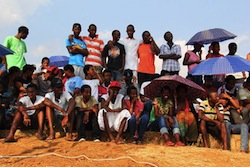East Africa’s first utility-scale solar field is making progress. When complete, it is estimated to produce 8 percent of the country’s power generation capacity. The project is going forward due to Dutch solar developer Gigawatt Global Coöperatief having successfully  closed on $23.7 million in financing for a 8.5 megawatt solar photovoltaic (PV) power plant from an international consortium of equity investors and debt providers including Norwegian development finance institution Norfund, Norwegian-headquartered Scatec Solar, Dutch development bank FMO and the Emerging Africa Infrastructure Fund (EAIF).
closed on $23.7 million in financing for a 8.5 megawatt solar photovoltaic (PV) power plant from an international consortium of equity investors and debt providers including Norwegian development finance institution Norfund, Norwegian-headquartered Scatec Solar, Dutch development bank FMO and the Emerging Africa Infrastructure Fund (EAIF).
The photovoltaic (PV) plant will be located 60 km from the capital of Kigali on land belonging to the Agahozo-Shalom Youth Village (ASYV) for youth orphaned during and after the 1994 Rwandan genocide. The electricity will be fed into the national grid under a 25 year power purchase agreement with the Rwanda Energy, Water and Sanitation Authority (EWSA). Construction has already started and commercial operation of the solar field is expected by summer of 2014.
“It takes a global village to raise a solar revolution,” said American-Israeli entrepreneur and human rights activist Yosef Abramowitz, President of Gigawatt Global and CEO of Energiya Global Capital, Gigawatt’s Israeli affiliate that provided seed money and strategic guidance for the project.
“There are 550 million people in Africa without electricity. Economic growth in developing markets depends on access to affordable, green power. Environmentally-friendly solar energy is far less expensive than diesel-generated power. This first-ever utility-scale solar field in Rwanda – and all of East Africa – represents the future of energy for developing countries and for island nations. It is a game-changer for humanity and the environment,” added Abramowitz.
The Rwanda Minister of State in Charge of Energy and Water, Eng. Emma Francoise Isumbingabo said, “Generation and provision of electricity to all Rwandans is important for the Government of Rwanda. This initiative to produce 8.5 megawatts is a good addition towards closing the current energy gap.”
With limited power generation capacity, the Government of Rwanda has introduced an aggressive plan to boost the nation’s generation capacity. The objective is for 50 percent of the population to have access to electricity by 2017.
Reflecting its dedication to helping heal the world, Agahozo-Shalom Youth Village fostered the development of a solar field, located on Village property, that will generate enough electricity to contribute to a roughly 8 percent increase in the country’s electricity supply. ASYV is leasing land to house the solar facility, the fees from which will help pay for a portion of the Village’s charitable expenses.

